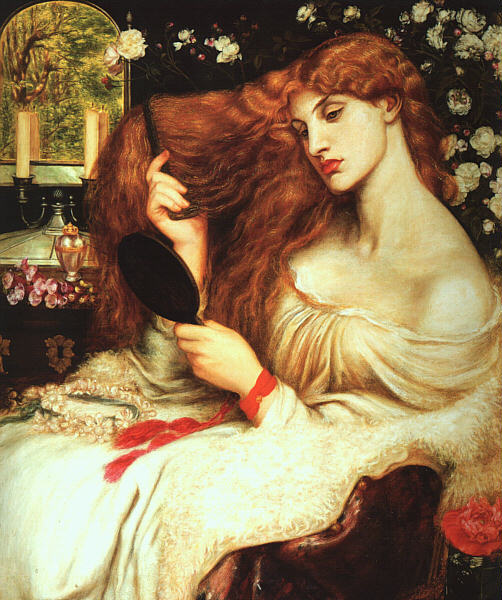Monday, April 30, 2007
Presentations- John Nay
Presentations- Jonathan Orsi
This is very much like Lysistrata, where the love between men and women is able to calm the warlike tendencies of humanity and turn their endeavors to more constructive ends. I also enjoyed Jonathan's presentation because it mentioned the power of love as calming Perseus. During the discussion of Lysistrata and several of the presentations I was a bit frustrated by the sheer amount of attention that was given to the power of women over men through their sexual prowess. While I'm sure there are countless members of both sexes who are so centered on the needs of their Id, it seems a bit insulting that men are so callously indentified by a desperate need for intercourse. This presentation's focus on love made the story of Perseus seem more complete and balanced, rather than yet another example of a woman "using what she has to get what she wants."
Presentations- Porter
The five conflicts are seen many times in the series, however the most prevalent is that of Man vs Woman- The conflict between Calvin and Susie is a stereotypical conflict, the dramatized traits of men and women (Men being headstrong, arrogant and forceful, Women being earnest, serious and contemplative) being let loose to ricochet off eachother. But with a closer look, this relationship also brings in the conflict of Old vs Young. Susie, as a hard-working and focused student, possesses a mature personality, giving her an aura of age and authority that Calvin finds threatening. Given his agonistic relationships with other female authority figures (His mother, Rosalyn, Miss Wormwood), Susie represents both the mystery and threat of feminism, the rigid authority of age, and the suffocating mandates of society.
Presentations- Emily Lewis
Presentations- Jann Spizziri
Although Cho's motives were much more obscured and nonsensical than those of Dionysus, both individuals were responsible for death and misery, and both left their victims with a last cutting monologue.
These speeches are quite alike in content, possibly because Cho had read The Bacchae during his english studies. Both speeches further condemn the victims by stating that there were numerous ways to have averted the disaster, and that they ignored the truth and their opportunities and so brought the calamity upon themselves.
Presentations- Chase Wright
The other main point of the essay was the theme of homophagia. While the myth of Dionysus has its fair share of cannibalism, it does not seem alike to the Christian eucharist's self-sacrifice.
Presentations- Alison Zobel
While these writings offer new viewpoints to traditional views of sexuality, I can't help but feel slightly skeptical about them. Perhaps it's some psychological defense mechanism where my masculine and chauvinistic ego can't stomach the idea of my sex being this tyrannical entity, or maybe my limited understanding of genetics and evolution makes me wonder how this evolutionary flux could cause the earliest humans to equate menstrual patterns with the concept of months. Regardless, I can't quite take a side for or against Shlain, though his writings do share an equal concept with Lysistrata.
Wednesday, April 25, 2007
The Fu

Yaki-fu is baked into long breadlike sticks and is most often added to soups to enrich their flavor.

And there you have it! The identity of that elusive Fu!
Coffeehouse Discussion- Memory
Each member of the group described the earliest memory they could recall. These included: being told of a close relative's death, a visit to the Smoky Mountains and hearing Dolly Parton music, watching crabs being cooked and actions taken while still inside the womb.
We then prepared to reenact the Madeleine scene of Proust by relating memory to that of the taste of foods. The foods included cheetos, apple sauce and juice, radishes, and Fu, which was largely unknown to the group.
After this discussion our group was assembled, our tea and Madeleines were ready, and we eagerly waited for the partaking of the ritual. After a quick reading of Proust's scene, we dipped our Madeleines into the tea and tasted them.
I can't say what everyone else felt, aside from the fact that they were delicious, but for me the Madeleine was similar to what Proust writes when saying that with each bite the amazing taste diminishes. My very first bite brought with it a strange, salty flavor, different from the tea and the taste that I experienced as I continued to finish the cake. With each bite it became sweeter and more like what I imagined it would taste like. I was equally puzzled when I ate a second and third Madeleine, there was no trace of that saltiness which had accompanied my first taste. In speaking with another member of the group, I was told that she had not noticed any such saltiness, making it seem that I merely imagined it. Or perhaps a few specks of salt had fallen into the mixture and gathered in the first Madeleine I had ever tasted; I like to think, however, that it was no coincidence or flight of fancy. I will instead choose to equate it with the mystery that defines all religious rituals and events, for it is that mystery that gives such experiences a sense of wonder which forever remains in our memories.
Thursday, April 19, 2007
Thoughts before the presentation
First Presentations
As far as the presentations went, both groups did extremely well. The first group was slightly confusing however, especially that they disembowelled someone who dressed in drag to prance around their rock star. Hmm, perhaps they don't like transvestites, or saw him as a threat to their amorous quest. Regardless, they decided to take the Ozzy Osbourne approach and take the poor guy's head off. They're some hard-core groupies to be sure.
The second presentation clearly pointed out that this semester has been dedicated to men being ridiculed and outwitted by women. First the right honorable George W. Bush (Or his cheerful visage at least) argues with his daughters over the crime of joining criminals in crimes, or some nonsense. He then is dressed up pretty so the suddenly mutinious women can derail his war machine. Finally, he makes the grave error of spying on the democrats. But while Nixon was lucky enough to get off with attempted impeachment, Dubya gets off with successful impalement, courtesy of the stiletto high heels of the babes in blue.
Wednesday, April 18, 2007
Till we have faces

Friday, April 13, 2007
Fragmentation in Satyricon
I later researched the story and found that the original text of Satyricon survives only in pieces, and that rather than attempting to fill in the gaps, Fellini chose to present the movie in a disjointed fashion as a view on the nature of history. While it doesn't help make the movie any clearer, it does explain the unique style of production.
I also was able to find W. C. Firebaugh's translation of the Satyricon as an ebook, complete with illustrations for each chapter. The text can be found at http://www.gutenberg.org/files/5225/5225-h/5225-h.htm
Tuesday, April 10, 2007
Eros and Psyche

Monday, April 2, 2007
Through a glass, darkly
Another Pygmalion
The video shows an intelligent, but unpopular student being bullied at school by both sexes. Unknown to him, one girl seems to be interested in him. Using some machine, he is then able to create, and give life to, a woman of his own design. This meets with disaster when his perfect woman develops into another cruel tormentor, leaving him for one of his more popular classmates. Unswayed, he attempts his experiment again, only to have his second Galatea abandon him. The finale shows the student once again about to create a woman, only to be stopped by his secret admirer. He then realizes that 'the perfect woman' is an impossibility, and that what he desired was there all along.
http://video.google.com/videoplay?docid=1025353659278747776&q=%22hole+in+my+soul%22&hl=en
The modern Pygmalion
 Rosetti's portrayal of Siddal is alike to Pygmalion's. He molds the image of a woman into one that he deems is perfect, objectifying her and creating an image of beauty and perfection impossible to be reached. His sister Christina describes his obsession in a poem title "In an Artist's Studio"
Rosetti's portrayal of Siddal is alike to Pygmalion's. He molds the image of a woman into one that he deems is perfect, objectifying her and creating an image of beauty and perfection impossible to be reached. His sister Christina describes his obsession in a poem title "In an Artist's Studio"
One face looks out from all his canvases,
One selfsame figure sits or walks or leans:
We found her hidden just behind those screens,
That mirror gave back all her loveliness.
A queen in opal or in ruby dress,
A nameless girl in freshest summer-greens,
A saint, an angel-- every canvas means
That same one meaning, neither more nor less.
He feeds upon her face by day and night,
And she with true kind eyes looks back on him,
Fair as the moon and joyful as the light:
Not wan with waiting, nor with sorrow dim;
Not as she is, but was when hope shone bright;
Not as she is, but as she fills his dream.

